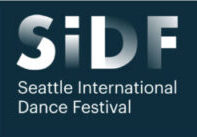“Seattle International Dance Festival” provides regional audiences the unique opportunity to see new work from local choreographers, as well as from visiting companies from around the globe.”
Daniel Costa Dance (DCD)
The world premier of Daniel Costa’s Interposition: Movement IIstarts slowly. One dancer walks to center stage, stands, and begins to sing a plaintive tune. Her cast mates watch from the wings. Slowly, they perform a series of solos, one dancer triggering the start of the next through a subtle touch or other physical interaction.
Costa’s full-body movements emanate from each dancer’s core and ripple through arms and legs, the way a heavy rope might vibrate if you grabbed one end and gave it a firm shake. Despite the required strength and athleticism, his choreography is plaintive, much like the original music by Devin Bews and songs by dancer Alicia Pugh. Together with the lighting and neutral-tone costumes, Costa conjures a melancholy mood that doesn’t shift at all during the piece, although several brief sections of unison dancing did bring a bit more emotional energy.
The cast was uniformly strong, and Costa’s written intent to “strip away shame and access vulnerability by channeling athleticism, artistry and healing through dance” is admirable. With Interposition: Movement IICosta has set up a good foundation to pursue that goal.
Version Excursion Dance
Choreographer Erin Nichole Boyt’sBack to Youbegins with perky women in short, perky dresses dancing to a perky song performed live by Beth Wesche and Darren Guyaz. The music then slows, and what unfolds is less a cohesive piece and more a series of vignettes performed to a series of songs. Unfortunately, each song required guitarist Guyaz to retune his guitar, leaving a gap between the dance sections that further exacerbated Boyt’s continuity problems.
Back to Youwas more an enthusiastic effort than a rousing artwork.
Julie Tobiason Ballet
Many long-time Seattle dance fans know Julie Tobiason from her career with Pacific Northwest Ballet, and subsequently with her own group, Seattle Dance Project, an early effort to present contemporary, ballet-inspired choreography. I was a big SDP fan, and lucky for me (and the SIDF audience), Tobiason continues to explore the intersections of classical ballet and contemporary dance in her latest work, kairos..
kairosbegins with a cheery balletic quartet, performed by four women in soft, rather than pointe, shoes. They cavort to a lively J.S. Bach gigue, played on classical guitar. They are enjoying themselves and each other, as well as Tobiason’s breezy balletic moves. Trouble arrives with two men; the heretofore carefree atmosphere is literally sliced by their rigid arm movements as they move in straight lines across the stage, to a vaguely Middle Eastern score.
Wouldn’t you know it, one of the women pairs off with one of the men, and they dance a flirtatious, whimsical pas de deux to a wildly syncopated piano/violin duet. They demonstrate both solid technique and a lovely dramatic flair.
The love doesn’t last. We watch the dancers gather for a party whose bonhomie is disrupted completely when one of the men gropes the party hostess. She is repulsed by his sexual advances, and fends him off in a powerful pas de deux.
kairos isn’t aliteral story, although it is structured in a loose narrative arc. As I took it all in, the word “sophisticated” kept coming to my mind. The dance was the final offering on the evening’s bill, and a wonderful way to end the program. Tobiason has assimilated all she learned during her years as a classical ballerina, and melded that knowledge with her work with contemporary dance. The result, kairos, was a treat for the SIDF audience; I look forward to what Tobiason creates next.
Marcie is an award-winning journalist and has covered the Seattle-area arts community for more than 30 years, for KUOW public radio, NPR, the BBC and numerous print publications including Dance, Pointe, and Dance Teacher magazines. In 2016, she published “Out There: Jonathan Porretta’s Life in Dance,” about Pacific Northwest Ballet principal dancer Jonathan Porretta. She writes about dance at her own blog, “And Another Thing,” www.marciesillman.com
